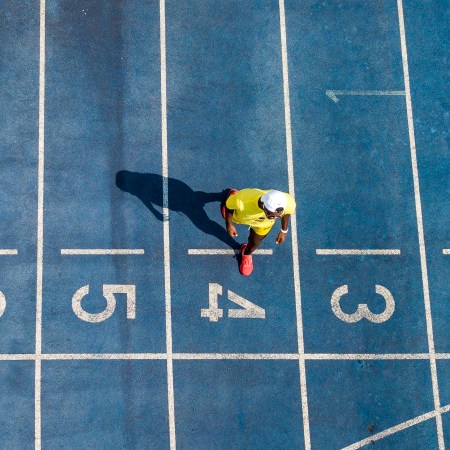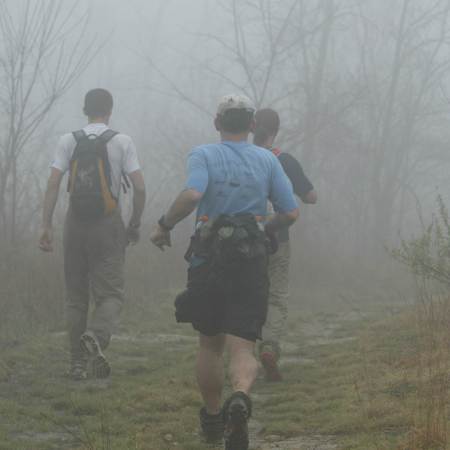Charles Stahler used to run back and forth across the Brooklyn Bridge every single day.
Forty-five years ago, he’d look up at the Watchtower’s clock to chart how long it took him to traverse the East River. He remembers the tower stairs as “good training,” but acknowledges — as the city did in 1982, when it removed them for good — that they were an impediment to cyclists. Stahler lives in Maryland now, but a few weeks ago, finding himself in New York, he went back to the Brooklyn Bridge. He managed a light jog.
Like much of the city’s beleaguered infrastructure, New York’s bridges don’t command much respect. Locals have learned to expect little from them. Any nice memory (like catching a glimpse of the skyline on a ride home) is marred in the end by each bridge’s obscene traffic — driving and walking traffic. The city’s most famous bridge is also the best example of this. Each day, 100,000 cars, 4,000 cyclists and 10,000 pedestrians cross the Brooklyn Bridge.
In 2020, the American Road & Transportation Builders Association classified the bridge as “structurally deficient.” It was a creative new riff on a familiar refrain. Three years earlier, the state comptroller declared 86 bridges across New York City as “functionally obsolete.” By one estimate, it would take roughly $164 billion and half a century to fix all of the city’s bridges.
It’s easier for some to dissociate entirely from this issue — lampoon the bridges, leave them to the unwitting tourists. But at least one community doesn’t have that luxury. New York’s runners must make the most of every cramped, concrete mile the city has to offer. In the city’s bridges, crumbling as they may be, they’ve found an unlikely ally, training tool and secret weapon.

In some ways, the link between New York’s bridges and running is obvious. Since 1976, when the New York City Marathon was altered from four-plus loops around Central Park, to a triumphant, five-borough tour of the city, Mile #1 has been a bridge: the Verrazano-Narrows.
As Roger Robinson, winner of the 1980 masters title wrote: “It’s not easy to plot a 26.2 mile course that touches each of the scattered five boroughs of New York City. Fred Lebow and other founding fathers who first devised that eccentric tour in 1976 had the idea of checking off the borough of Staten Island in the first steps of the race. Assemble at Fort Wadsworth, line up on the toll plaza, run straight for the bridge, and cross to Brooklyn. That’s Staten Island done.”
The move, which Robinson dubbed “a stroke of genius,” gave New York Road Runners a billboard photo for all time, and the race its iconic moment. Verrazano-Narrows is one of the steepest points of the entire course, but race operators blast Frank Sinatra’s “New York, New York” as runners climb. The water glitters below, the city does so in the distance and it’s too early for the pack to stratify. It’s marathon Sunday magic at its finest.
Later on, runners must also cross the Queensboro Bride, just before Mile #16, at which point they’re likely running alone, terrified of bonking and without any spectator support. Some might take solace in F. Scott Fitzgerald’s old quote from The Great Gatbsy: “The city seen from the Queensboro Bridge is always the city seen for the first time, in its first wild promise of all the mystery and the beauty in the world.” Most just can’t wait for it to be over.
Crucially, these inclusions were born from necessity. New York is a maritime city; the simplest way to get around it on two feet is to cross its bridges. But that necessity doesn’t just impact race architects in charge of constructing a cogent course. It bleeds into the everyday training of the city’s most faithful runners. I recently asked a friend of mine — who’s run the Cape Cod Marathon and the Hamptons Marathon — to name his favorite run from this year. He picked a Friday 12-miler from the end of August, which took him over both the Brooklyn Bridge and Williamsburg Bridge.
As a Brooklyn-based runner, my friend frequents Prospect Park’s 3.35 outer loop like everyone else. But when he’s looking for something different (this run brought him all the way to FiDi, then up the Hudson River Greenway) he enlists a bridge. It’s the easiest way for him to actually reach 12 miles without needing to run in circles. During peak marathon training, it’s even more important. Most runners build up to distances of 20 to 22 miles, and spend at least three hours on their feet. It’s only natural to use as much of the city as possible.
Plus, bridges don’t just offer a change in scenery. They provide a much-needed change in elevation. Kevin Mejia, a senior account executive who’s worked on PR campaigns with On, has been running around New York for five years. He says: “I actually trained for the very hilly Athens Authentic Marathon using the bridges to help. I do think the lack of steep hills throughout the city (other than the dreaded Harlem Hill in Central Park) plays a major part in why runners choose to utilize bridges in training.”
According to Mejia, seasoned runners understand that each bridge offers a unique set of advantages and challenges. For his money, “the new Kosciuszko Bridge is by far the nicest with ample room for runners.” The R.F.K. Bridge (formerly known as the Triborough Bridge) is his least favorite in terms of access. And the Williamsburg Bridge has the steepest hill.
Williamsburg is actually my “home” bridge, and learning over time that its ramps are abnormally sloped relative to other bridges throughout the city — they climb towards the bridge’s height of 135 feet above the water — came as welcome relief. The first time I made it to the top, heaving, I was genuinely concerned that my lung capacity had taken a step back. But the key is to embrace that test. New York, remember, is a flat city. Its highest point is Todt Hill in Staten Island. Much of Manhattan is flattened land, reclaimed land. The sort of topography that senior citizens are assured in Tripadvisor forums will not pose an issue to their “dodgy knees.”
But for those of us with more youthful knees, the labor of running up and down bridges is instrumental. Hill workouts improve running economy. They boost muscle strength and lactate threshold, help us refine poor biomechanics (by encouraging short, concise strides) and optimize the body’s entire process of knowing how, and when, to send oxygen to the legs. Not to mention: they’re a mental toughness feast. New York runners are pretty gritty to begin with — they regularly deal with extreme weather swings, overgrown rodents and Uber drivers who’ve seemingly been commissioned to run them down in the street. But bridges give them that one more opportunity to test their mettle, while legitimately becoming a better runner in the process.
Which is why the local running community has made bridges a cornerstone of their training and racing philosophy. Consider The Rise NYC, a group that meets on Fridays at 7am to run repeats on Williamsburg Bridge. Once in a while, wary that the runners might “master” the incline, the organization’s coaches will flex the session to a different bridge in the city. Meanwhile, when conceptual race operator Trials of Miles hit the scene in 2020, its very first idea was the Four Bridges Challenge, a “race” in which runners are tasked with crossing the Brooklyn, Manhattan, Williamsburg and Queensboro bridges in a single run.
Trials of Miles has grown substantially in size and notoriety since I competed in another one of its projects (Survival of the Fastest, a March Madness-style single-elimination running tournament) in June 2020. It now has roots in other running cities like Boston and Austin and has leveraged partnerships with Brooklyn Running Company, Evil Twin Brewing and Tracksmith. But the collective’s very first idea involved New York’s bridges. The current “fastest known time” (FKT) for Four Bridges belongs to a man named Brendan Martin, who completed the 14-mile route in 1:11:15. That’s a mile pace of 5:05.
The man behind Trials of Miles, Cooper Knowlton, says: ““I think running is inherently a really exciting sport, but too often it’s packaged really poorly. The main thing that interests me is trying to come up with races and challenges that are exciting, somewhat unconventional, and also viewer-friendly.” Sometimes, the races that emerge from that line of thinking don’t even resemble running. For instance: Knowlton’s latest initiative is The Five Borough Bet, an adventure taking place this very night, where a field of runners will see who can visit every single borough and return first to an On Running pop-up in North Williamsburg. (Touching the Staten Island Ferry door counts for visiting that pesky fifth borough.) How will they do it? A mix of running and public transportation, however they see fit. Bridges, one would imagine, will come into play.
Last and certainly not least, there’s also Take the Bridge, a summer racing series created by Darcy Budworth in 2015, in which a select group of runners race NYC bridges on a rotational basis. Their group’s About section copy says it all: “we race bridges no mile markers no time clocks only pure urban racing competing by intuition pacing on gut.” TTB races sell like concert tickets — one season-ending September race sold 40 slots in less than a minute. The races start as late as 10:30pm, with operators waiting until the night’s cooled and whatever bridge they’re barnstorming has largely emptied out. Then someone sets up a couple cones, draws the starting line in chalk, and they’re off. If it sounds raw and unsanctioned, well, that’s sort of the point. According to Tempo, Budworth started the initiative because she loved running over bridges.
If anyone has shown New York’s bridges unconditional love, it’s the city’s runners. Years from now, they may well be rewarded for it. Early stage planning is underway for up to three different pedestrian-and-bike bridges. The jewel, nicknamed Queens Ribbon, attracted some buzz when renderings were released last summer. But the other two could prove equally seismic: slender suspension bridges linking Lower Manhattan to Brooklyn, and Jersey City to Battery Park.
These proposals, like any big idea in this area, face uphill battles. They’ll need city and state approvals, public and private investments, significant compromise throughout. But if they do happen, some future Charles Stahler will inevitably make a habit of running back and forth on one every single day. And either way, just like the 33,000 about to cross the Verrazano-Narrows this Sunday morning, New York runners will keep running up and down bridges, chasing wild promises.
This article was featured in the InsideHook newsletter. Sign up now.






















